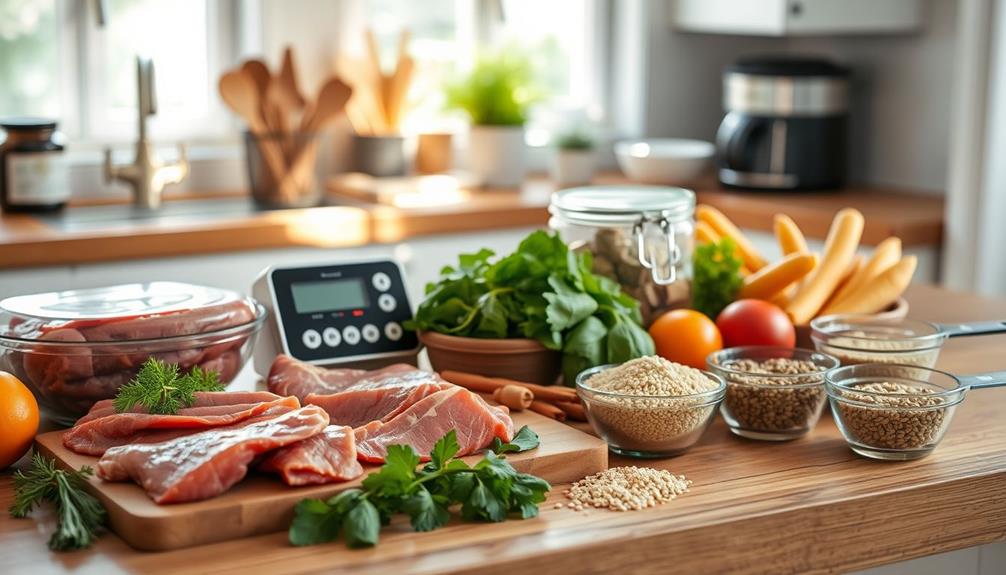Measuring raw food for your dog is all about understanding its specific nutritional needs. Use a raw food calculator, which considers your dog's weight and activity level to determine daily portion sizes. Most adult dogs need about 2-4% of their ideal body weight in food daily. Puppies, however, require more—up to three times that amount! Monitor your dog's weight regularly to make necessary adjustments. Also, remember to maintain proper food handling to guarantee safety. If you need more detailed guidance and tips for a successful raw feeding shift, you might find valuable insights ahead.
Key Takeaways
- Use a raw food calculator to determine daily calorie needs based on your dog's ideal weight and activity level.
- Adult dogs typically require 2-4% of their body weight in raw food daily, while puppies may need 2-3 times that amount.
- Monitor your dog's weight regularly, adjusting food intake by 10-20% if they are underweight or overweight.
- A balanced raw diet should include 70-80% muscle meat, 10% edible bone, and 5-7% organs for optimal nutrition.
- Gradually transition to raw food by mixing current food with raw food, observing your dog's response throughout the process.
Understanding Raw Food Calculators
When you're diving into raw feeding for your dog, understanding raw food calculators is crucial. These tools help you determine the right amount of raw food your dog needs based on their ideal weight and activity level. You'll input your dog's specifics, and the calculator will provide tailored daily calorie needs and food intake in various units like pounds or kilograms.
It's important to track your dog's progress and adjust their diet as needed to guarantee they receive peak nutrition, similar to how you'd create a personal budget for managing finances.
For adult dogs, a typical Dog Food Calculator suggests that muscle meat should comprise 70-80% of the diet, with edible bone at around 10% and liver or organs making up 5%. If you're feeding puppies, you'll notice the percentages shift slightly; muscle meat should be 58-69%, with a higher proportion of bones and organs to support their growth.
Additionally, raw meaty bone calculators can guide you in finding the ideal weight of raw meaty bones, often recommending bone percentages between 10% to 20% based on your dog's requirements.
Many of these calculators even allow you to receive detailed calculations via email in PDF format, giving you easy access to personalized feeding guidelines tailored for your furry friend.
Daily Calorie Requirements
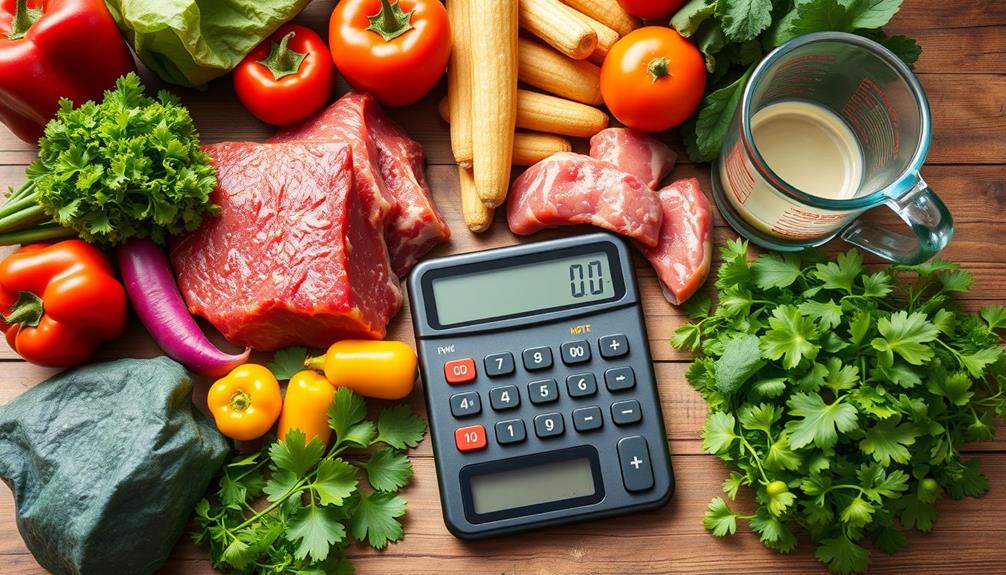
Determining your dog's daily calorie requirements is vital for maintaining their health and energy levels. These requirements depend on factors like ideal weight, age, activity level, and metabolic rate. For adult dogs, you'll typically need to provide around 2-4% of their body weight in calories daily. Puppies, on the other hand, may require 2-3 times that amount for their growth.
Here's a quick reference table to help you understand the daily calorie needs based on your dog's weight:
| Dog Weight (kg) | Daily Calorie Needs (grams of raw food) |
|---|---|
| 10 | 200 – 400 |
| 20 | 400 – 800 |
| 30 | 600 – 900 |
| 40 | 800 – 1200 |
You can calculate the precise amount of raw food using feeding calculators tailored to your dog's weight and activity level. Regularly monitor your dog's weight and adjust the amount of raw food accordingly to prevent obesity or underweight issues. Keeping track of these daily calorie requirements is significant for your dog's overall health.
Canine Nutritional Needs
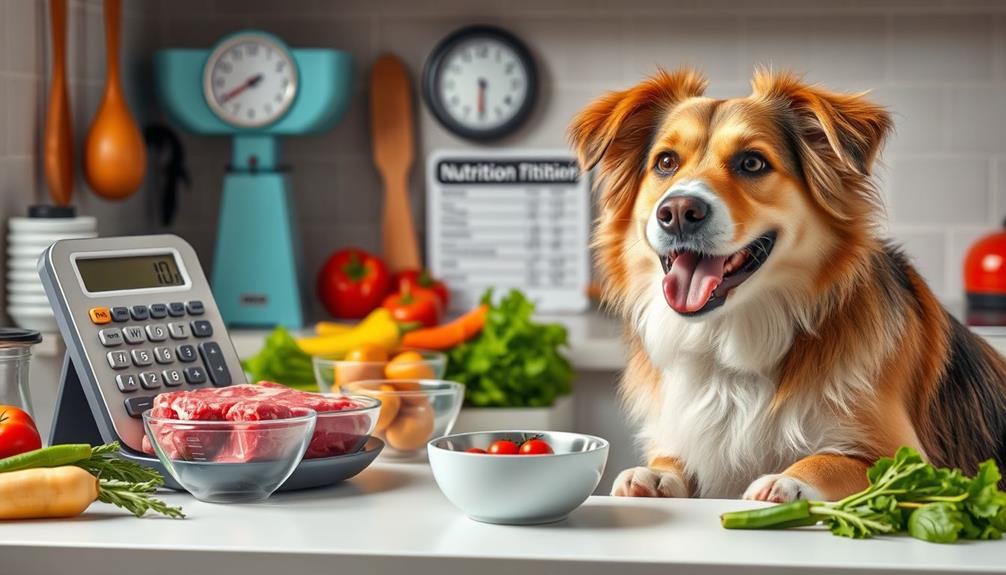
Understanding your dog's nutritional needs is essential for their overall health and well-being. Canine nutritional requirements vary based on factors like age, activity level, breed, and metabolic rate, so it's vital to create a tailored dietary plan.
For adult dogs, you typically need to provide 2-4% of their ideal body weight in food daily. Puppies, on the other hand, may require two to three times that amount because they're growing rapidly.
It's also important to take into account safe food options and treats, similar to how safe snacks for hamsters should be chosen carefully.
A balanced raw diet for dogs should ideally consist of 70-80% muscle meat, 10% edible bone, and 5-7% liver and organs, with about 7% vegetables.
It's important to regularly monitor your dog's weight, as this will help you adjust food portions accordingly. If your dog is overweight, you may need to reduce their intake, while underweight dogs might require increased portions.
Feeding Guidelines for Adults
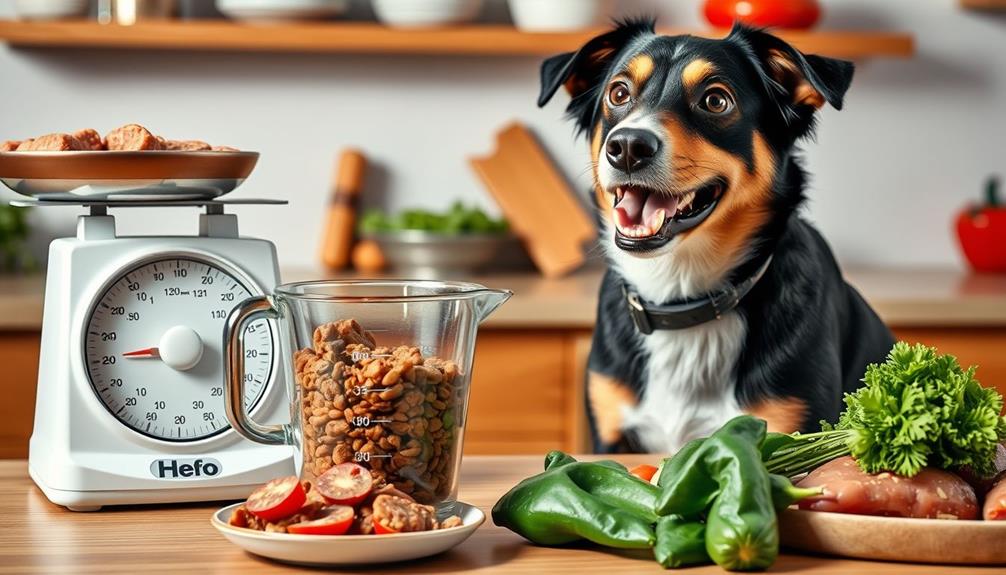
When it comes to feeding adult dogs, daily portion recommendations are vital for maintaining their health.
It's important to take into account their activity level, as dogs with higher energy needs will require more food, while less active dogs should have their portions adjusted accordingly to guarantee they stay at an ideal weight.
Incorporating a balanced diet rich in fruits and vegetables can also contribute to their overall well-being.
Regular monitoring and adjustments will help keep your furry friend in top shape.
Daily Portion Recommendations
To guarantee your adult dog thrives on a raw food diet, aim to feed them 2-4% of their ideal body weight each day, adjusting based on their size and activity level.
It's important to take into account that factors like age, health conditions, and even behavioral aspects can influence their dietary needs, which is similar to how caregivers must assess financial considerations for elderly care to guarantee proper support.
For example, if your dog weighs 30 kg (about 66 lbs), this means a daily intake of 600-900 grams (21-32 oz) of raw food.
Remember that smaller dogs typically need a higher percentage of their body weight for maintenance compared to larger breeds.
It's wise to start feeding at around 2-2.5% of their ideal body weight, then monitor their weight and health regularly, making adjustments as needed.
Feeding guides are just that—guides. Your dog's specific needs and their response to the raw diet will play a significant role in determining the exact amount of food to provide.
Keep an eye on your dog's energy levels, coat condition, and overall health to guarantee they're getting the right nutrition.
Activity Level Considerations
Activity level considerably impacts how much raw food your adult dog needs. Generally, adult dogs require 2-4% of their ideal body weight in raw food daily. More active dogs may need up to 4% to maintain their energy levels. For instance, a 30 kg dog with moderate activity would need around 600-900 grams of food daily.
To help you understand how different activity levels affect feeding amounts, here's a quick reference:
| Activity Level | Percentage of Body Weight |
|---|---|
| Low (Couch Potato) | 2% |
| Moderate (Daily Walks) | 3% |
| Active (Playtime) | 3.5% |
| Very Active (Working) | 4% |
| Senior (Less Active) | 2-3% |
Regularly monitor your dog's weight and activity level to guarantee their food portions are adjusted accordingly. It's also beneficial to divide their daily portion into two meals to help with digestion and energy distribution. This way, you'll keep your furry friend healthy and happy!
Weight Maintenance Strategies
Maintaining your adult dog's ideal weight is key to their overall health and well-being. To achieve this, you'll need to feed them 2-3% of their ideal body weight daily.
Smaller dogs typically require a higher percentage, while larger breeds need less. For instance, if your dog weighs 30 kg, aim to provide between 600g to 900g of food each day.
Start at around 2-2.5% of their body weight and adjust as necessary. Regular weight checks are essential, as they allow you to monitor your dog's condition and make any necessary adjustments to their food portions.
Additionally, consider incorporating natural remedies alongside conventional methods to support your dog's diet and health.
If your dog is overweight, consider reducing their intake, while underweight dogs may need more food to reach a healthy weight.
Puppy Feeding Recommendations
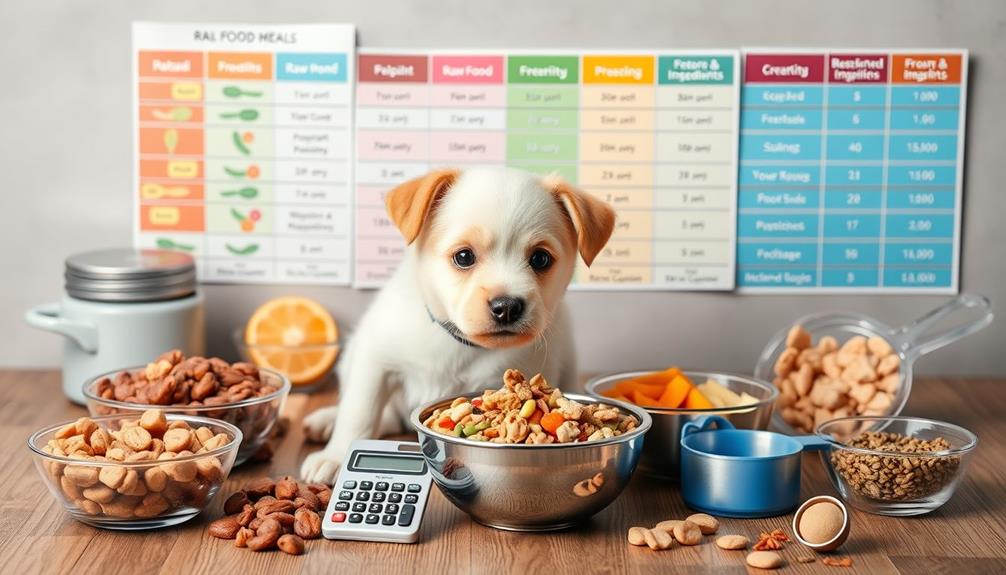
When it comes to feeding your puppy, understanding their unique nutritional needs is essential.
Just like the unexpected antics that can occur during a family photoshoot, feeding can sometimes involve trial and error to find the right balance. You'll want to follow specific feeding frequency guidelines and keep a close eye on their weight to guarantee they grow healthy and strong.
Additionally, puppy feeding recommendations should emphasize the importance of monitoring their dietary changes as they grow.
Let's break down how to meet those needs effectively.
Feeding Frequency Guidelines
Puppies need careful attention to their feeding frequency to support healthy growth and development. For very young puppies, feeding them 3-4 times daily is vital. This guarantees they receive the adequate nutrition needed for their rapid growth.
As your puppy matures, you'll typically shift to twice-daily feedings, which should be sufficient to meet their dietary needs. Providing healthy dog snacks can also enhance their overall wellness and keep them engaged.
When determining how much food to feed, remember that puppies generally require 2-3 times the amount of food compared to adult dogs, based on their weight and growth stage. It's important to adjust feeding portions according to your puppy's age, weight, and breed.
For instance, a small breed puppy might have different requirements than a large breed puppy.
Close monitoring of your puppy's weight and overall health is essential. Regularly check your puppy's body condition and adjust the feeding amounts accordingly during this growth phase.
Nutritional Needs Overview
To guarantee your puppy thrives, understanding their nutritional needs is fundamental. Puppies have unique nutritional requirements, needing 2-3 times more food than adult dogs to support their rapid growth and development. Very young puppies should be fed 3-4 times daily, while older puppies typically do well on twice-daily feedings.
Key domains of development in psychology highlight the importance of proper nutrition in early life stages, as it directly influences their physical and cognitive growth.
It's imperative to adjust the amount of food based on your puppy's age, weight, and breed to make sure they receive adequate nutrition. If you're considering RAW feeding, it's important to calculate their daily food intake based on their ideal body weight and specific dietary needs. This tailored approach helps maintain peak health and supports proper growth.
Close monitoring of your puppy's growth and health is essential. Underfeeding can stunt their development, while overfeeding may lead to obesity and other health issues.
Weight Monitoring Importance
Monitoring your puppy's weight is essential for ensuring they grow healthy and strong. Puppies require considerably more food than adult dogs—about 2-3 times the amount—making weight monitoring indispensable. By keeping a close eye on their intake, you help facilitate proper growth and development.
Engaging your puppy with toys that promote fine motor skills, such as best educational construction toys, can also encourage their physical activity and contribute to a healthy lifestyle.
Very young puppies should be fed 3-4 times daily, while older puppies typically thrive on two feedings per day. This consistent feeding schedule helps maintain their energy levels and supports nutrient absorption.
Remember, adjustments in food amounts are necessary based on your puppy's age, weight, and breed, as each breed has unique growth rates and nutritional needs.
Regular weight checks allow you to gauge if your puppy is growing at an appropriate rate. If you notice any substantial deviations, it's time to reassess their diet.
Monitoring your puppy's weight not only helps maintain ideal health but also safeguards against obesity or malnutrition as they shift to adult feeding guidelines.
Ultimately, weight monitoring is an important part of raising a healthy puppy that will develop into a well-adjusted adult dog.
Transitioning to Raw Diets
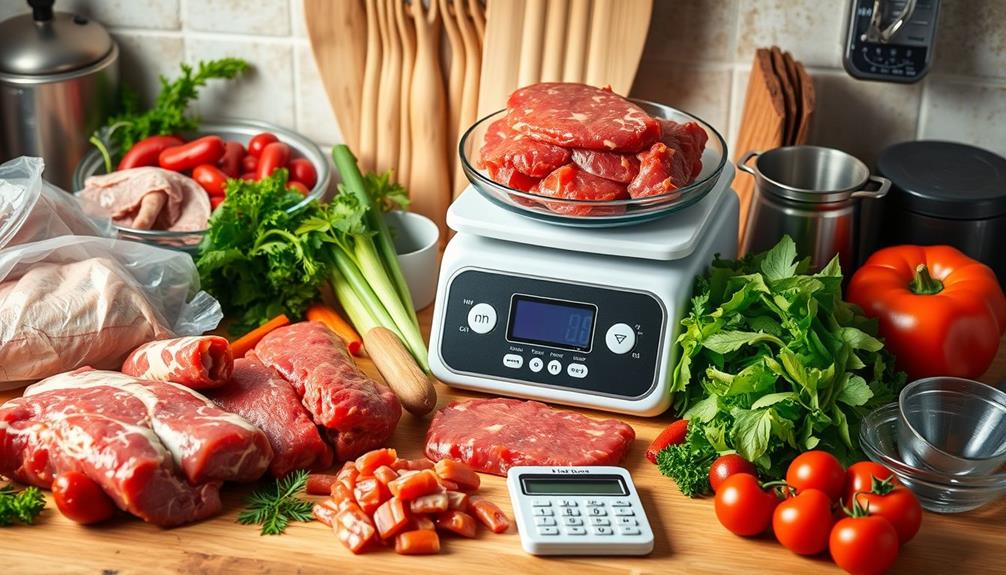
Shifting your dog to a raw diet can be a rewarding journey, but it's important to do it gradually. Start by mixing 1 part raw dog food with 3 parts of their current food. Over the next 1 to 2 weeks, slowly increase the raw portion while decreasing the previous food. This gradual adjustment helps your dog adapt to the new diet without digestive issues.
Additionally, consider incorporating essential oils like eucalyptus oil for promoting overall respiratory health in your dog during this change.
During this period, keep an eye on your pet's temperament and stool quality. Positive changes indicate that they're adapting well to the raw diet. Puppies often need more frequent meals, usually 3-4 times a day, while adult dogs can thrive on twice-daily feedings.
Adjust the food amounts based on your dog's age, weight, and activity level to guarantee they get the right nutritional balance. Each dog is unique, so tailor their diet accordingly.
For more guidance on safely adjusting to raw food, consider checking out resources like the "Starting on Raw Food" page. This way, you'll be equipped with the knowledge to make the switch smooth and successful for your furry friend.
Monitoring Weight and Adjustments
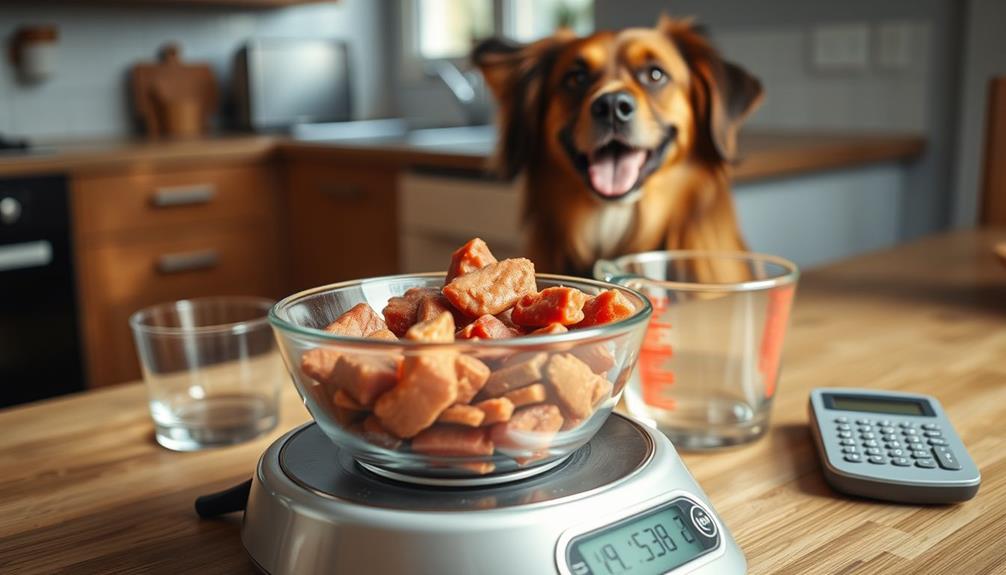
Regularly checking your dog's weight is essential for guaranteeing they stay within a healthy range on a raw diet. Aim to monitor their weight every 2-4 weeks. This practice allows you to determine if you need to adjust their food portions.
If your dog is overweight, consider reducing their food intake by 10-20%. Conversely, if your dog is underweight, you might need to increase their food by the same percentage to help them gain healthy weight.
To help with these adjustments, you can use a Food Calculator for Dogs, which calculates the appropriate daily food quantity based on your dog's current weight, age, and activity level.
Keeping a log of your dog's weight changes and any dietary adjustments is also beneficial. This record can help you identify patterns over time and inform future feeding decisions.
If you notice significant weight fluctuations or if managing your dog's weight becomes challenging, don't hesitate to consult with a veterinarian. They can provide tailored advice and help guarantee your dog maintains a healthy and balanced diet while on their raw food journey.
Safe Handling Practices
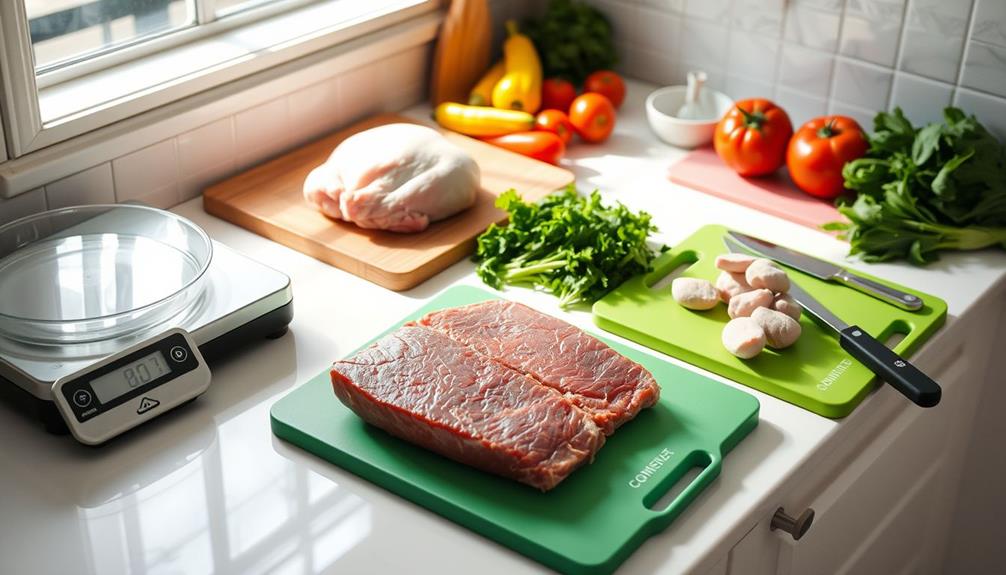
Maintaining your dog's weight within a healthy range is just one part of feeding them a raw diet. Practicing safe handling is essential for both your pet's health and yours. Always treat raw pet food as unprocessed meat. Wash your hands thoroughly after touching it to prevent cross-contamination.
Here's a quick guide to safe handling practices:
| Practice | Action | Frequency |
|---|---|---|
| Hand Washing | Wash hands with soap and water after handling raw food | Every time you handle raw food |
| Surface Cleaning | Clean surfaces and utensils with hot, soapy water | Before and after preparing food |
| Food Storage | Store raw pet food in refrigerator or freezer | Daily |
Avoid mixing raw food with dry kibble to reduce cross-contamination risks. Regularly test raw pet food for contaminants like salmonella and E. coli to guarantee safety. Following these safe handling practices keeps your furry friend healthy and minimizes any risks associated with feeding raw diets.
Additional Resources and Support
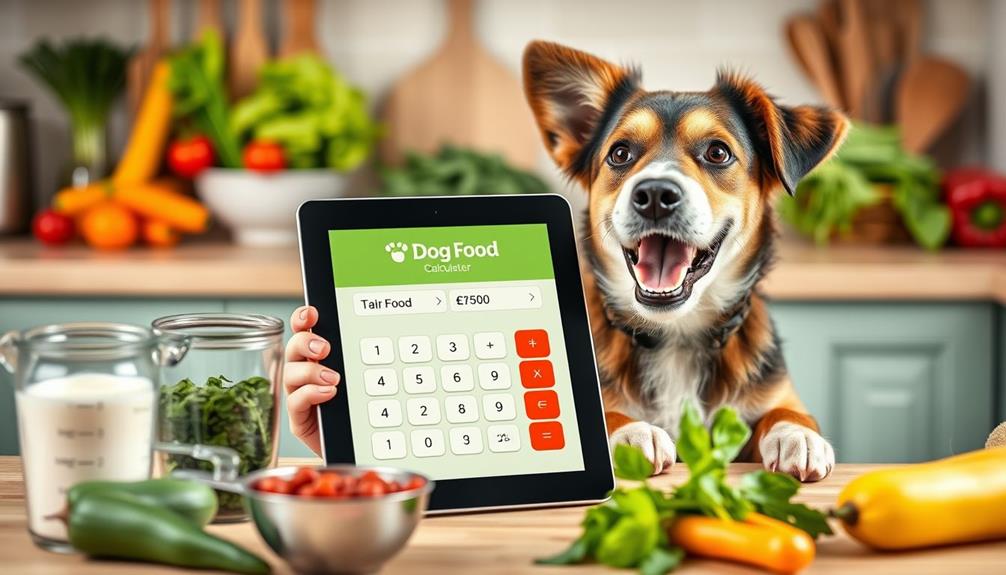
When changing your dog to a raw food diet, having the right resources at your fingertips can make all the difference. To help you navigate this shift effectively, consider utilizing these essential tools and support:
- Raw Pet Food Feeding Calculator: This handy tool helps you determine personalized feeding amounts based on your dog's weight and dietary needs, guaranteeing a balanced raw food diet.
- Beginners Guide To Raw Feeding: This thorough guide offers valuable insights for those new to raw feeding, covering everything from food selection to portion sizes.
- How To Switch To Raw Food: This resource provides step-by-step instructions and tips for converting your dog smoothly to a raw diet.
- Community Forums and Support Groups: Connect with other raw feeding pet owners to exchange experiences, tips, and best practices.
Don't forget to monitor your pet's weight and health regularly. Adjust food portions as needed, and if you have questions about feeding calculations or raw diet management, reach out to the support team at rawdogfoodcalculator@gmail.com.
With these resources, you'll guarantee a successful shift to raw food for your furry friend.
Frequently Asked Questions
How to Calculate Raw Dog Food Portions?
To calculate raw dog food portions, determine your dog's ideal weight and multiply it by 2-3%. For puppies, use 2-3 times that amount. Adjust portions based on weight changes to maintain a healthy range.
How Do You Measure Raw Meat for Dogs?
So, you think guessing your dog's meat portions is a fun game? You're wrong! Measure raw meat using a digital scale, targeting 2-3% of their ideal weight, adjusting for their activity and individual needs.
What Is the 80 10 10 Rule for Raw Dog Food?
The 80 10 10 rule means you'll feed your dog 80% muscle meat, 10% edible bone, and 10% organ meat. This balance guarantees they get the nutrients they need for peak health and energy.
How Do I Calculate How Much Food to Feed My Dog?
To calculate how much food to feed your dog, start with their ideal weight. Aim for 2-3% of that weight daily, adjusting based on their activity level and regular weight monitoring for peak health.
Conclusion
In summary, measuring raw food for your dog is essential for their health and happiness. Did you know that 60% of dogs in the U.S. are overweight or obese? This startling statistic highlights the importance of proper nutrition. By using a raw food calculator and following guidelines tailored to your dog's needs, you can help them maintain a healthy weight and live a longer, happier life. Always remember to monitor their progress and adjust accordingly! When calculating raw food for puppy, it’s especially important to ensure they are getting the right balance of nutrients for their growing bodies. Puppies have different nutritional needs compared to adult dogs, so following a specific feeding plan for them is crucial. Using a raw food calculator tailored specifically for puppies can help ensure they are getting the right amount of protein, fats, and other essential nutrients for their development. This attention to their diet will set them up for a lifetime of good health and vitality.

